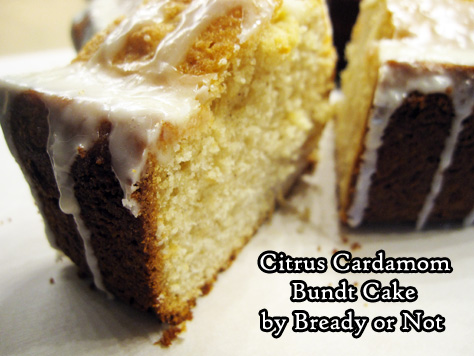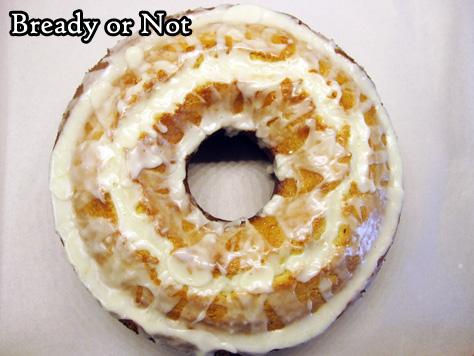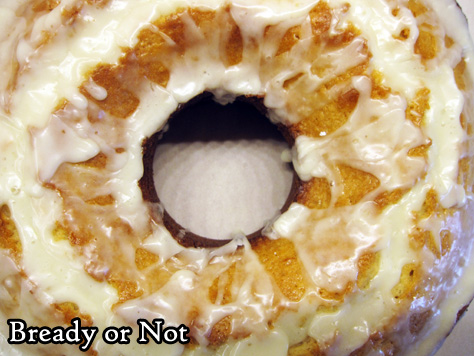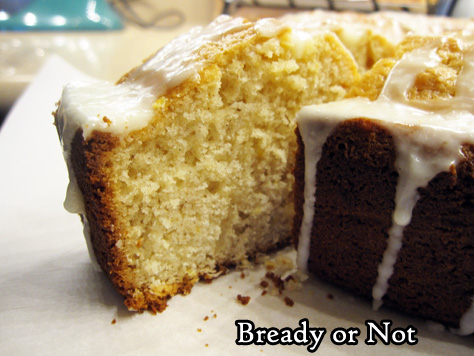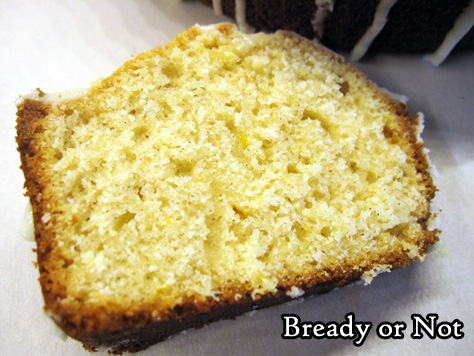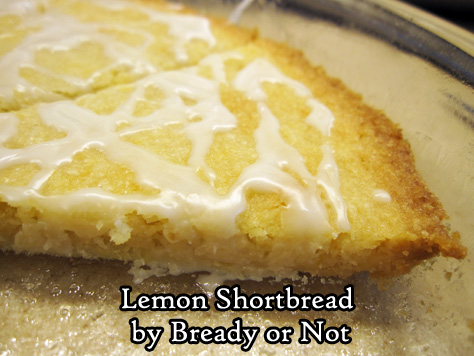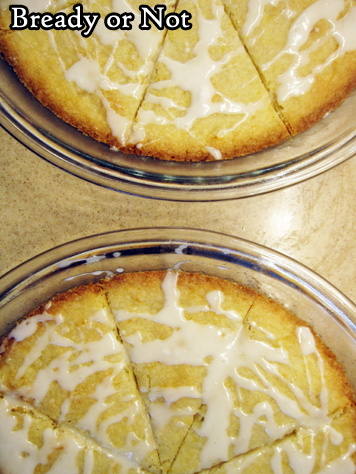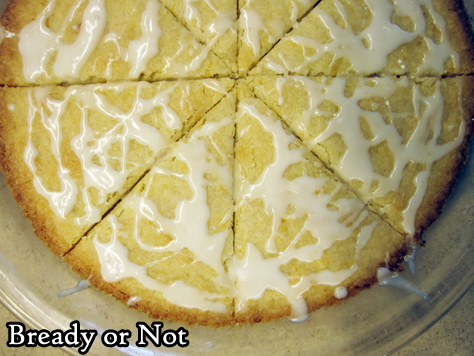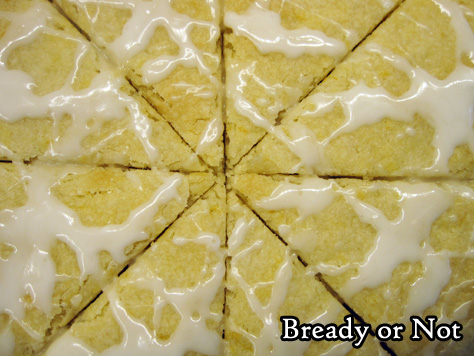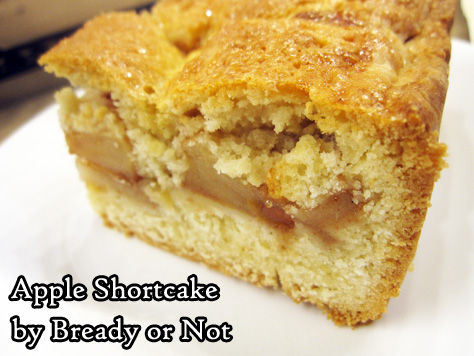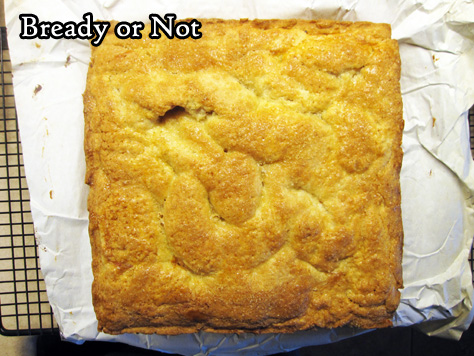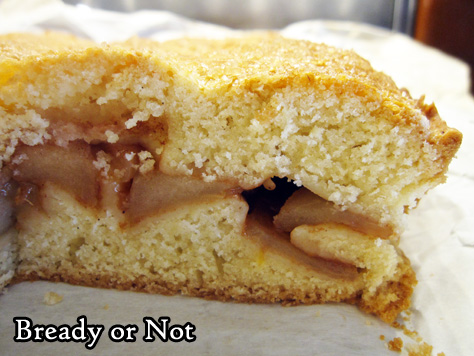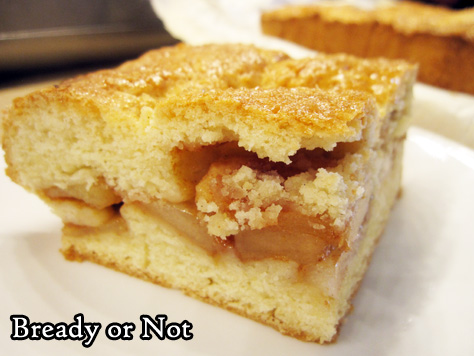Bready or Not Original: Citrus Cardamom Bundt Cake
This Citrus Cardamom Bundt Cake beautifully combines orange and lemon with classic spices, creating a cake that tastes and smells divine.
Above all, this cake is imbued with wonderful freshness. Citrus does that, and this cake has a heady dose in the batter as well as the glaze.
Cardamom is one of my favorite spices, one that I crave to use more often. A teaspoon and a half is in this recipe, and as strong as cardamom is, it comes through in a potent, refreshing way.
I made it in a tube pan, because I had a brand new one I needed to try out, but this would also be great in a large bundt pan.
Make this to feed a crowd for breakfast, brunch, or dessert. It would be delicious at any time of day or during any season of the year!
Bready or Not Original: Citrus Cardamom Bundt Cake
Equipment
- tube or bundt pan
- baking spray with flour
Ingredients
cake:
- 3 cups all-purpose flour
- 1 1/2 cups white sugar
- 2 teaspoons baking powder
- 1 1/2 teaspoons ground cardamom
- 1/2 teaspoon ground cinnamon
- 1/2 teaspoon salt
- 1/2 cup orange juice
- 2 large lemons zested and juiced
- 2/3 cup canola oil
- 1 teaspoon vanilla extract
- 3 large eggs room temperature
glaze:
- 1 cup confectioners’ sugar
- 3 teaspoons orange juice
- 1 teaspoon lemon juice from reserved juice
Instructions
- Preheat oven at 350-degrees. Use a floured baking spray on the entire interior of a bundt or tube pan.
- Combine the flour, sugar, baking powder, cardamom, cinnamon, and salt. Pour in the 1/2 cup orange juice, 1/4 cup of the fresh lemon juice, canola oil, all of the lemon zest, vanilla, and eggs. Beat until combined, scraping the bottom of the bowl occasionally.
- Pour the batter into the pan and level it. Bake for 45 to 55 minutes, until a toothpick comes out clean. Let cool in pan for about 15 minutes before inverting onto a wire rack.
- After another 10 minutes, assemble glaze to create a thick, slow-dribbling consistency. Drip it over the warm cake to coat the top and ooze along the sides. Cool cake completely.
- Store cake covered at room temperature. Pieces can be individually sliced to take on the go or to freeze for later.
OM NOM NOM!
New Publications to End May
I’ve had a smattering of new publications over the last month and now I finally have the chance to update my site! The Bibliography is now current. Here’s what is new:
Short stories:
- “The Right Cornbread” in Nature
- “To Meet the Death Carriage” in Daily Science Fiction
Poetry:
- “Another Life” in Gwyllion Magazine Issue 4
- “Timeless Pie” in Uncanny Magazine (Issue 46 May/June 2022)
Translation:
- “Nadat Haar Broer de Hoofden van Haar Papieren Poppen Trok” (“After Her Brother Ripped the Heads from Her Paper Dolls”) translated into Dutch in Speculatief Magazine
#SFWAPro
Read MoreBready or Not Original: Lemon Shortbread
My Shortbread recipe was the first I really mastered as a teenager beginning to bake. This new version uses that as a base, but modifies it into a delicious Lemon Shortbread.
I love a good Scottish Shortbread. It’s so buttery and scrumptious. The fresh zing of lemon plays very well with that inherent butter flavor and texture.
This is not a crisp shortbread like the traditional Walker’s brand (which is delicious in its own right). No, this shortbread is cakey and soft, only crisp at the very edge.
Sometimes the first piece out of the pan can even be fussy and break in half; a metal pie spatula helps, but sometimes it can still happen. That’s no major problem, though, because of every bite of Shortbread is good, even if it’s not perfectly photogenic.
This new version does have a photogenic advantage, though, because the glaze is so very pretty. It should be just thick enough to drizzle, though if it’s a touch watery, that’s not the end of the world.
Enjoy this Lemon Shortbread for breakfast or snacks, or in proper fashion at tea time.
Bready or Not Original: Lemon Shortbread
Equipment
- 2 pie plates
Ingredients
Shortbread
- 1 lemon zested and juiced
- 2 cups all-purpose flour
- 3/4 cup white sugar
- 1/4 teaspoon salt
- 1 cup unsalted butter (2 sticks) softened
- 1 egg yolk
- 1 teaspoon lemon flavor
- 1/2 teaspoon vanilla extract
Lemon Glaze
- 3/4 cup confectioners’ sugar
- 1 Tablespoon lemon juice
Instructions
- Preheat oven at 375-degrees. Apply nonstick spray to both pie plates.
- Stir together the lemon zest, flour, sugar, and salt. Add butter, egg yolk, lemon flavor, and vanilla extract. Use hands to compress dough together to make a ball. Divide in half, placing one in each pie plate. Flatten dough with palms to create an even surface. Prick surface all over with a fork then use a knife to slash dough into triangular wedges.
- Bake for 18 to 22 minutes, until edges are golden brown and middle is set. Remove from oven and cut again along slash marks. Let shortbread cool completely.
- In a medium bowl, stir together confectioners’ sugar and lemon juice to create a glaze with a consistency to drip and keep shape. Drizzle all over shortbread. Let set, then cut again along existing marks.
- Shortbread keeps for several days at room temperature. It can be stored covered in pie plates, or stacked in a sealed container with wax paper between the layers.
OM NOM NOM!
Bready or Not: Apple Shortcake
This Apple Shortcake is fussy to make, but the results are absolutely delicious!
I modified this from a recipe in Bake from Scratch, the September/October 2020 issue. There, they describe this style of shortcake as a New Zealand favorite.
Here in American, I grew up with strawberry shortcake (and loved the cartoon and toys for Strawberry Shortcake in my earliest years), and thought of fruit shortcakes as being simply made in individual portions. I was intrigued by this idea of it being like a cake and pie hybrid.
The most annoying thing about the recipe is that I found the dough to be quite sensitive–but this also might be an Arizona problem, as my kitchen year-round is hotter than many get. The good thing is that the recipe makes a lot of dough, so it’s easy to patch any tears or holes with a bit of the leftovers.
The baked shortcake is dense and delicious, with perfectly-spiced apples in a kind of shortbread sandwich.
The shortbread keeps okay at room temperature up to 2 days. If you’re feeding a small crowd, no prob–cut it into individual pieces, encase in plastic wrap, and freeze. It keeps fantastically that way.
Modified a lot from Bake from Scratch, September/October 2020 issue.
Bready or Not: Apple Shortcake
Equipment
- food processor
- food scale
- 9×9 pan
- Rolling Pin
- pastry brush
Ingredients
- 4 cups all-purpose flour plus more for rolling
- 1 cup plus 3 Tablespoons white sugar divided
- 1 3/4 teaspoons baking powder
- 1 1/4 teaspoons plus 1/8 teaspoons kosher salt divided
- 1 cup cold unsalted butter
- 3 large eggs divided
- 3/4 teaspoons almond extract
- 1/2 teaspoon vanilla extract
- 3 large apples such as Granny Smith and Pink Lady
- 1 lemon zested and juiced
- 2 teaspoons corn starch
- 1 teaspoon ground cinnamon
- turbinado sugar optional to sprinkle on top
Instructions
Make the crust
- In the bowl of a food processor, pour in the flour, 1 cup sugar, baking powder, and 1 1/4 teaspoons salt, then pulse until combined. Cut the butter into cubes and add to the bowl, pulsing until the mixture resembles coarse crumbs. Add 2 eggs and the extracts. Pulse to bring the dough together so that it's moist but not sticky; if it doesn't come together, add a small amount of water and pulse more.
- Turn out the dough to press it together. Use a food scale to weigh the dough and divide it in two. Wrap each piece with plastic wrap. Chill in fridge for at least 30 minutes, or up to a few days.
Assemble the shortcake
- Preheat oven at 350-degrees. Let the dough stand at room temperature for about 10 minutes. Sprinkle flour on a flat surface and roll out one portion of dough to make a 13-inch square. Set the pan on top as a guide to cut an even 9×9 square.
- Line pan with foil and apply nonstick spray. Place cut square inside. It’s okay if it tears as its being moved–patch it with fingertips. Pat the leftover dough up the sides of the pan to completely cover, sealing the edges together along the bottom and at the corners. Chill pan during the next step.
- Peel the apples and cut into quarter-inch slices, placing them in a large bowl. Add the lemon zest and 2 teaspoons of juice. Stir to coat apples. Add the cornstarch, cinnamon, remaining 3 Tablespoons sugar, and last bit of salt. Toss everything together, coating the apples. Spread the apples evenly across the bottom of the pan.
- Roll out remaining dough to make a 10-inch square to completely cover the top of the apples. Press overlapping edges to seal together, trimming dough if needed. Lightly beat the remaining egg then brush it over the top crust. Use a fork to poke the crust all over to create vents. If desired, sprinkle turbinado sugar across the crust.
- Bake until crust is golden brown, about 50 minutes to 1 hour. The apples should be tender if poked with a toothpick. Let cool in pan for at least an hour. Use foil to lift shortcake onto a cutting board for easy slicing.
- Store cake in sealed container at room temperature for up to 2 days. It can also be cut into individual slices and frozen for later enjoyment.





